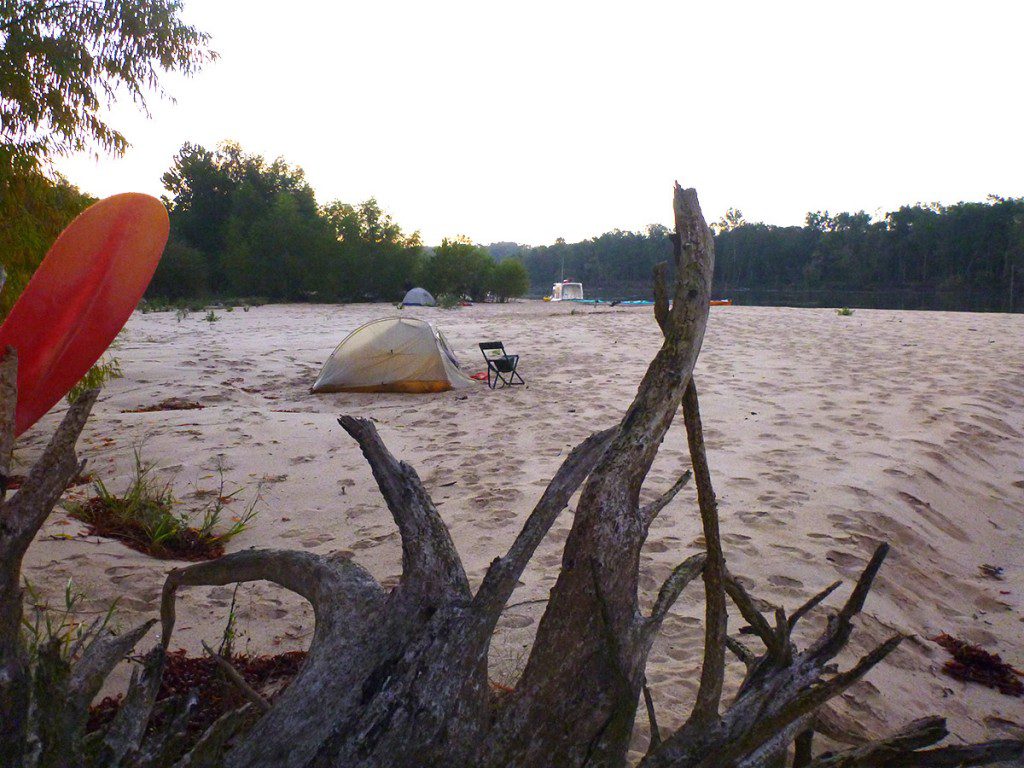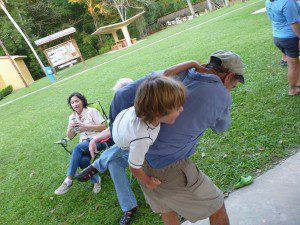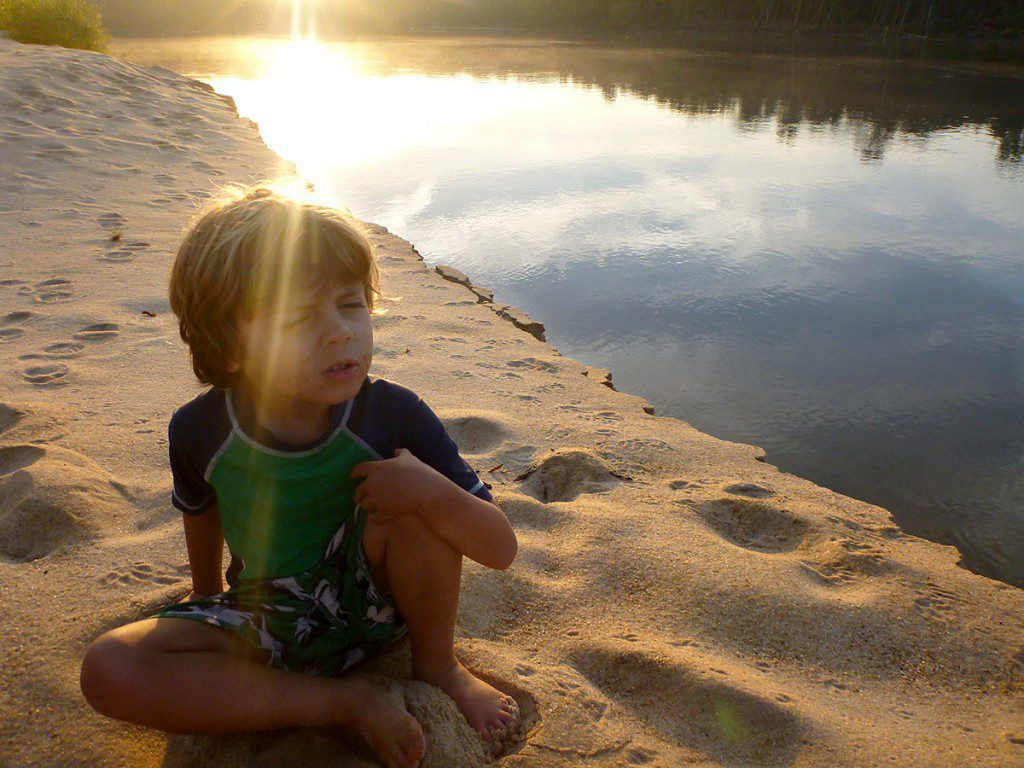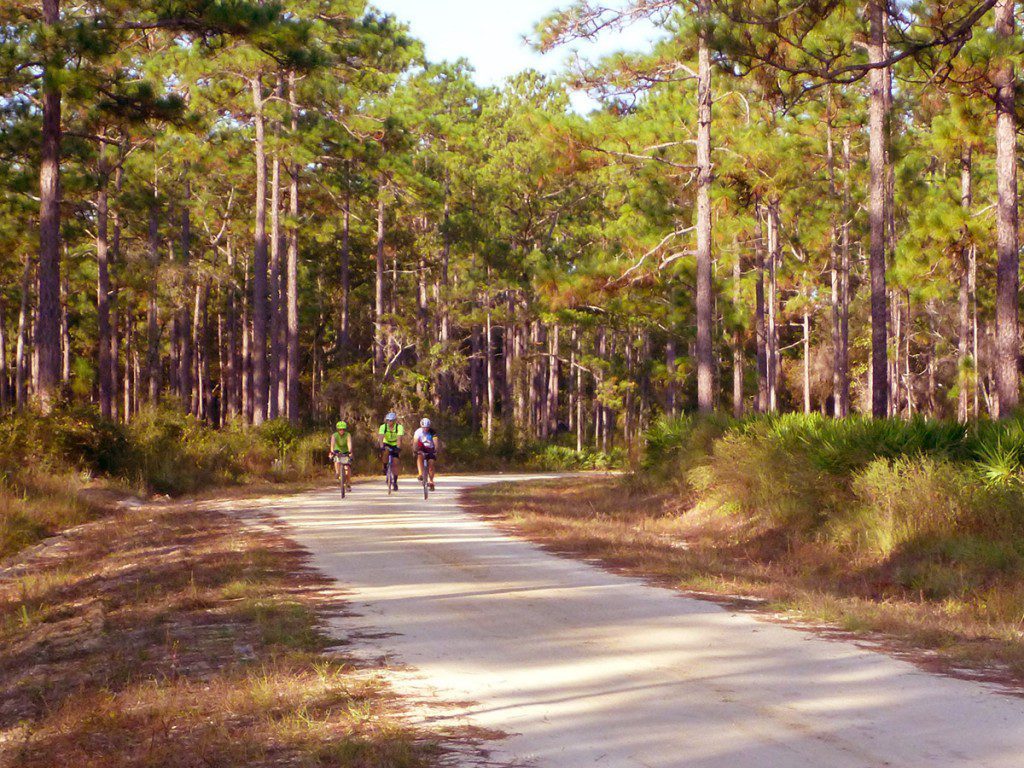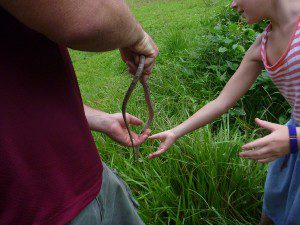WFSU producer Rob Diaz de Villegas heads down the Apalachicola River once again, this time with his best adventure buddy. This year’s RiverTrek also featured the very first River Ride, with cyclists hitting small river towns and forest roads.
Rob Diaz de Villegas WFSU-TV
Max wanted to do one thing above all else: climb Sand Mountain. But, as I was gathering camping gear for our trip on the Apalachicola, I got an e-mail from RiverTrek coordinator Georgia Ackerman. The water was high this year, and she wasn’t sure there would be a place to park our kayaks on the steep face of the giant sand spoil. As a parent of a four-year-old, you learn the dangerous nature of expectations. You have to be careful never to promise anything which isn’t 100% guaranteed to happen. Four-year-olds don’t necessarily grasp “maybe.”
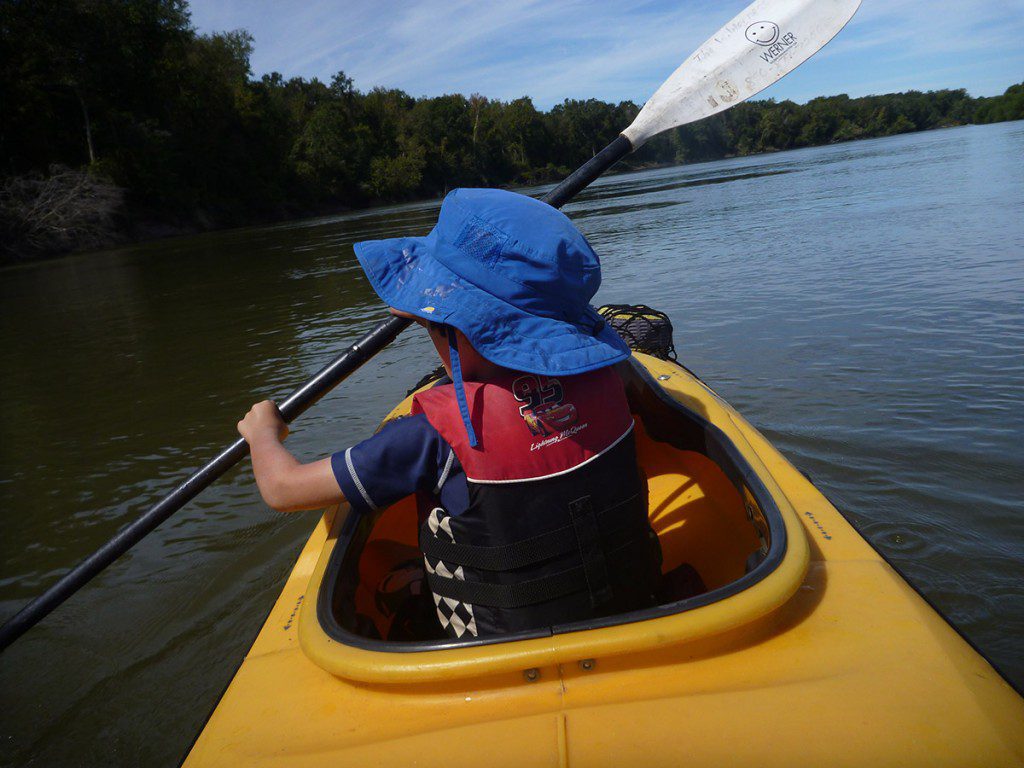 I decided to prepare him for the possibility of a Sand Mountain-less RiverTrek in as straightforward a manner as possible, to minimize an on-river explosion. He laughed off my warning. He wasn’t buying it.
I decided to prepare him for the possibility of a Sand Mountain-less RiverTrek in as straightforward a manner as possible, to minimize an on-river explosion. He laughed off my warning. He wasn’t buying it.
In regards to this trip, I had some Sand Mountain sized hopes of my own. I wanted this to be a great experience for Max; but also, with fresh young eyes along, it could be as new to me as it was on my first RiverTrek in 2012. I finished the videos from that first trip at a time when I would show one-year-old Max short Youtube clips at breakfast- mostly sea turtle hatchlings running to the Ocean. RiverTrek soon made it into our rotation.
Then, Max would start asking my wife, Amy, to tell him the story of “Daddy kayaking down the Apalachicola River.” When we’d visit the Tallahassee Museum, he could care less about seeing a Florida panther if a group of kayakers was passing by its enclosure. And every body of water was the Apalachicola River, even on a beach looking at the Atlantic Ocean.
I was surprised and delighted that he latched onto the Apalachicola like he did. It was a first step to a family life filled with canoeing and camping trips. Well, that was happening anyway, but I definitely liked the prospect of the children happily participating.
When the possibility of taking Max on a RiverTrek trip arose, I was excited. Then I was scared. It was time to find out whether the Apalachicola River was more fun in Daddy’s stories, or with its sand in your toes and its water dripping onto your hands from a kayak paddle.
We started “training” a year ago. I took him on short kayak trips, and we camped a couple of times along the river. I’ve chronicled some of that on the blog. Each adventure had small challenges that ended up making the trips more fun than if I knew what I was doing a little better. The time a raccoon stole our hot dog buns at Torreya State Park is now canonized in family lore, and Max now swears that eating hot dogs without buns is the best way.
He loves camping. I had no doubts that he would love camping on a sandbar, right on the river. But would he tolerate sitting in a kayak as I paddled twenty miles a day for two days?
Lucky for me, he became obsessed with climbing Sand Mountain. We’d get there on our second day (the fourth day of RiverTrek), so he’d look forward to it all the first day. I Photoshopped a couple of Apalachicola Blueway maps, adding mile markers and photos of key attractions, and laminating them for river use. Once on the water, he’d keep pointing at the Sand Mountain photo, and ask “Are we seeing Sand Mountain today? Are we climbing Sand Mountain today?” “No, that’s tomorrow, son. We’ll see how high the water is.”
In the end, I worried needlessly. While Sand Mountain doesn’t typically offer much of a shoulder for kayaks, the water was just high enough to put us where the sand was a little less steep than it had been on my first visit. As for my second greatest RiverTrek worry, that it would be too much work for him to climb, he laughed that off as well. Weighing just under 40 lb., his feet didn’t sink into the sand as he climbed, much as grown folks’ feet tend to do. Compared to me, he sort of glided up (do you hear me panting in that video?). Once up top, he was having the time of his life before getting hungry.
“Max,” I yelled as he ran off, “wait here!” By the time those words were uttered, he was already zipping down. Not only did he climb Sand Mountain “easy-peazy-lemon-squeezy,” he did it twice. And barefoot. The much-feared meltdown did almost happen when it was time to leave, and more than a few tears were shed in the kayak after “not enough time” there.
But he got over it. Max’s expectations were satisfied, and a great memory was made (and captured on video forever). We traveled forty miles of the Apalachicola River, climbed Sand Mountain, and slept two nights by the water.
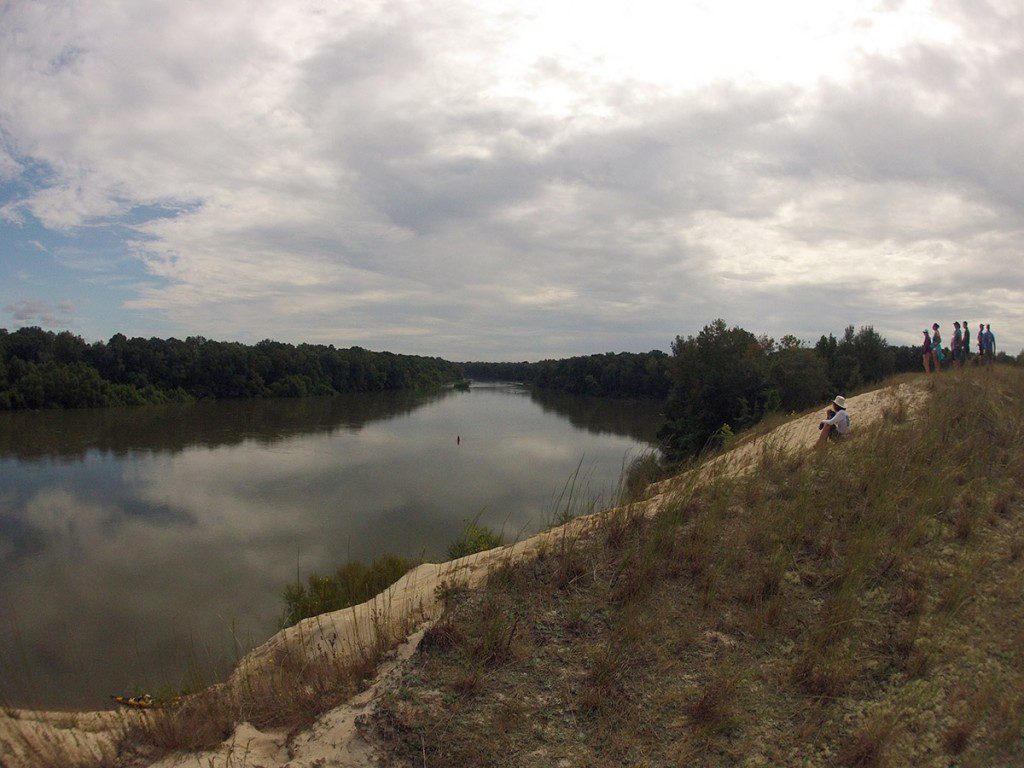
Sand Mountain is comprised of sediments dredged from the river bed. It represents something of an ecological upheaval, but it does offer a nice view.
How do you entertain a 4-year old on a long kayak trip?
Max’s conception of what this trip would entail came from 15 minutes of video distilling the most interesting moments of a five-day trip (plus some stuff about oysters and the need for more fresh water that he’d occasionally ask to skip). I had trouble conveying what the rest of the time would be like. Some would call it monotony, others would call it serenity. The problem I set my focus on was this: how would I keep him engaged for two days of sitting in a kayak?
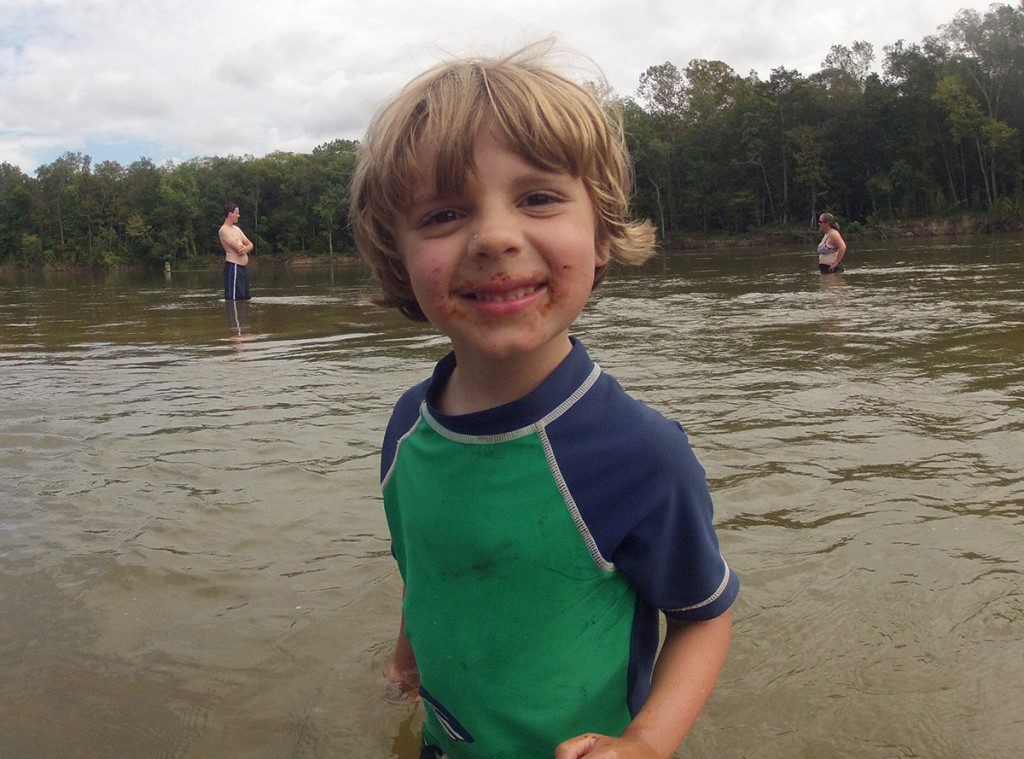 Food. From previous trips, I knew that food would be key. More food than I’d normally pack for myself (I have no problem eating a peanut butter and jelly sandwich for lunch and dinner). Dinners would be provided on the two nights we’d be going, so I had to pack breakfasts, lunches, and snacks. Max associates protein bars with camping, so that needed to be our breakfast, and I usually pack oranges as well. Max likes a banana while kayaking, but they’ll go bad within a few hours of being on the water, so that had to be one of his first snacks. I decided to get a nut mix with chocolate in it. Wouldn’t that be fun? It was until partway through the first day. I learned that most of the year in Florida, chocolate will melt in your kayak. Now, did that stop Max from eating it? I think the photo says it all. And no matter how messy the food I brought, he could always wash right off.
Food. From previous trips, I knew that food would be key. More food than I’d normally pack for myself (I have no problem eating a peanut butter and jelly sandwich for lunch and dinner). Dinners would be provided on the two nights we’d be going, so I had to pack breakfasts, lunches, and snacks. Max associates protein bars with camping, so that needed to be our breakfast, and I usually pack oranges as well. Max likes a banana while kayaking, but they’ll go bad within a few hours of being on the water, so that had to be one of his first snacks. I decided to get a nut mix with chocolate in it. Wouldn’t that be fun? It was until partway through the first day. I learned that most of the year in Florida, chocolate will melt in your kayak. Now, did that stop Max from eating it? I think the photo says it all. And no matter how messy the food I brought, he could always wash right off.
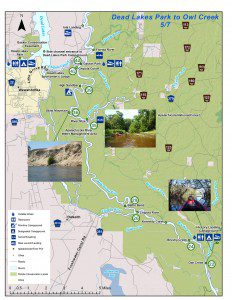 The maps. This was an idea I had on our previous trip. Max would be my navigator. Florida DEP’s Office of Greenways and Trails created maps for the Apalachicola Blueway paddling trail, broken into seven PDFs. I downloaded the two corresponding to our trip and took them into Photoshop, where I added mile markers (there’s a handy list on the Apalachicola Blueway web site) and photos of key features. I had the WFSU Education Department laminate them so that he could hold them in the kayak and see where we were going. You can see several shots in the video of Max holding his maps, including his runs up and down Sand Mountain. It’s tricky getting into your kayak from the edge of the Sand Mountain, and I unknowingly sat on my map while hopping in. When, downriver a little ways, Max noticed that he didn’t have it, he ordered me to paddle upstream and climb back up and get it. Luckily, there is one last sand bar on the river after Sand Mountain, and we found the map at lunch.
The maps. This was an idea I had on our previous trip. Max would be my navigator. Florida DEP’s Office of Greenways and Trails created maps for the Apalachicola Blueway paddling trail, broken into seven PDFs. I downloaded the two corresponding to our trip and took them into Photoshop, where I added mile markers (there’s a handy list on the Apalachicola Blueway web site) and photos of key features. I had the WFSU Education Department laminate them so that he could hold them in the kayak and see where we were going. You can see several shots in the video of Max holding his maps, including his runs up and down Sand Mountain. It’s tricky getting into your kayak from the edge of the Sand Mountain, and I unknowingly sat on my map while hopping in. When, downriver a little ways, Max noticed that he didn’t have it, he ordered me to paddle upstream and climb back up and get it. Luckily, there is one last sand bar on the river after Sand Mountain, and we found the map at lunch.
Toys. Not as important as I thought. I brought some water proof beach toys and a snorkel, thinking he could use them while playing on sandbars. But who needs toys when you have…
People! Georgia Ackerman and Doug Alderson, the trip’s co-coordinators, always do a great job selecting the team. But Max is a high energy child, and at his age he’s still learning about boundaries and acceptable behavior. I woke him at 6 AM to drive to Estiffanulga, where we’d meet with the ‘Trekkers as they started their third day. He was full-steam ahead from wake up until I convinced him that it was time to go to sleep, after a good amount of campfire time. He didn’t want to miss anything. Most of all, he wanted to hang out with everyone.
Luckily, people seemed to have fun with him. And if they didn’t, they were too nice to let on. Max loved spending time with all of them. He put his hands on Lynne Buchannan’s hands to give her energy (She’s a photographer and has chronicled the trip on her own blog, which has some great photos). During dinner at Owl Creek, he ran off while I was talking to WFSU videographer Samantha Hunter, who met us there, and I found him on Katie McCormick’s lap. And, on this trip, I learned that Riverkeeper Dan Tonsmeire is great with kids. Dan let Max stay in his boat while I set up our tent on a sand bar (next to the Riverkeeper boat, as per Max’s request), and Dan outlined his response to the new Army Corps of Engineers water manual draft for him. A couple of weeks earlier, Max told his mother that he wanted to be “a famous Riverkeeper of the Apalachicola.” On this trip, Dan got to start grooming the next generation of river stewards. Evidently that involves a lot of being picked up and spun around. And muffins.
Anyhow, to any and everybody who participated in RiverTrek or the Apalachicola River Ride this year, thank you for making Max’s experience amazing!
The Splendor of Sand Bars
I think the complexity of issues facing the Apalachicola River basin could be summed up in Max’s love for sand bars and Sand Mountain. Back when the Apalachicola was a shipping lane for barges, the Army Corps of Engineers dredged sand from the bottom of the river to make it deeper. Dykes narrowed and straightened the channel, a process known as channelization. This makes the river flow faster, favorable for barges on a schedule but less so ecologically, as faster water increases erosion and disrupts the distribution of water into the flood plain. Wide sand bars, created from dredge material, also narrow the channel and hasten erosion. However, Max loves them.
On our first night, we camped on a high sandbar north of Wewahitchka. I parked my kayak on one side of the sand bar, where I proceeded to set up a tent. Max spotted the Riverkeeper boat on the opposite end of the sand bar and talked me into setting up there. Among the RiverTrekkers, the word most associated with the sand bar was “Sahara,” for its impressive width and depth. Imagine how vast the sand bar seemed to a four-year-old. Just when I thought I would sit and chat with some folks, Max was off to explore his desert paradise.
“When you get them out here at this age, it’ll always be familiar to them,” Jim McClellan told me as Max wandered out to the water’s edge. Jim should know, having hunted and fished around it while growing up in Calhoun County.
It took Max a long while to be able to sit still by the campfire that night. A couple of paddlers were hanging out by the Lily, captained by Gill Autrey in support of the paddlers on the last couple of days of the trip. I put a light stick around Max’s neck and let him run between the fire and the boat. Eventually, he sat on my lap and joined us in looking for falling stars. Not a bad end to the day.
Cycling the Apalachicola National Forest/ Tate’s Hell
This was a year for firsts on RiverTrek. Not only did we have our youngest ever participant, but there was a cycling component running alongside as well.
“I think one of the big things is to actually visit a few of the small communities along the way.” Said River Ride coordinator Rick Zelznak, who kayaked on the 2012 RiverTrek. “We started in Chattahoochee. We stopped and had lunch in Bristol, where we had a chance to talk to some of the locals there. Same thing in Sumatra. An opportunity to see some of the creek crossings that go down into the Apalachicola, and also an opportunity to spend some time in the communities that are supported by the river.”
Bicycles are a faster conveyance than kayaks, so Rick and Brian Ruscher only had a two-day trip. They were joined on parts of their trip by Florida Representative Halsey Bashears, Doug, Georgia, and ’12 and ’13 RiverTrekker Alex Reed. It worked out nicely with my RiverTrek plan; as I knew I wanted to do days 3 and 4 so that Max could climb Sand Mountain. Day 4 was the Riders’ first day, which ended at Owl Creek with the ‘Trek crew. We all camped together, and Amy came and got Max the following morning. Editing the video, it warmed my heart to see everyone calling out “Maaaaaaaaxxxx!” before departing. I was a little sad for my adventure with him to end, but also excited to follow the River Riders through forest lands.
About 15 of the 40 miles on day 2 were on dirt roads. Owl Creek is in the Apalachicola National Forest; from there they rode to Fort Gadsden (also in the ANF) and out to State Road 65. They then rode to Tate’s Hell State Forest, which contains many creeks within the Apalachicola delta (we saw some of these on an early EcoAdventure, where you can hear how the forest got its name). From there, Brian strapped on a GoPro and got shots of forest riding, and a nice view of the group riding over the Gorrie bridge and into Apalachicola (and with Alex on flat tire).
With a relatively short day, they were there well ahead of the paddlers, who were greeted by a flock of seagulls as they came up alongside Apalachicola.
Eating Some Real River Food in Wewahitchka
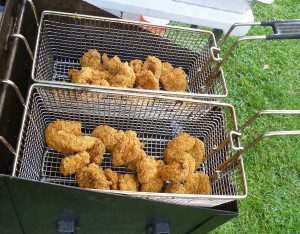
Fried gator tail, caught on Iamonia Lake (the oxbow the Apalachicola, not the Tallahassee lake) by 2015 RiverTrekker Jim McClellan.
A few months ago, Jim McClellan took us out on Iamonia Lake to find turkey and get a little fishing done. Jim wrote an account of growing up in Calhoun County, “Life Along the Apalachicola River.” Much of it took place on Iamonia Lake, an oxbow of the river that Max and I passed on our first day of paddling (mile marker 55). While we didn’t see Jim catch a single thing on our earlier shoot, he did afterwards manage to catch a mess of bream and shell cracker, along with some gator tail, which became our dinner at Wewahitchka. Jim kayaked on this year’s RiverTrek, gaining a new perspective on the river on which he was raised.
Cooking that dinner were Matt Godwin, Kelli Jackson, and Ryan Walden of Off the Map Expeditions. That was Max’s first taste of gator, which he liked. Last year, Matt and Kelli guided us through the Dead Lakes and took us to an apiary during tupelo honey season.
The new Army Corps of Engineers Water Manual draft for the ACF Basin
As with any RiverTrek, after the kayak and camping fun ends, the issues in the river and bay remain. Dan Tonsmeire shared with us a few reasons for cautious optimism, including the Water Manual draft. While he doesn’t find it favorable to the Apalachicola system, the Army Corps of Engineers will be taking input again, so it’s another chance for anyone affected to make their voice heard. The Corps will hold a public input meeting at the Apalachicola National Estuarine Research Reserve in East Point on November 9, from 4-7 pm. Here is a link to their press release about the draft and other meetings (three in Georgia, one in Alabama).
The Army Corps of Engineers works by rules set by congress. Representative Gwen Graham has introduced the Apalachicola Bay Restoration Act, which would mandate that the Corps release more water than currently required. During a drought in 2012, the Army Corps released the minimum allowable flow, 5,000 cubic feet per second, for ten consecutive months. 5,000 cfs is the lowest amount allowed by the current manual, based on the needs of mussels protected by the Endangered Species Act. 2012 was the lowest recorded flow in the history of the Apalachicola River, and during that drought the Apalachicola Bay oyster fishery collapsed. Riverkeeper Tonsmeire does report that numbers are improving in oyster beds in the eastern half of bay.
WFSU-FM’s Lynn Hatter recently took a long look at how Apalachicola Bay got to where it is today. Part one aired today, and we’ll link to part two when it goes online (there it is!).
More Kids in Nature
The 2015 RiverTrek was one of two stories I produced for Local Routes this week, and both feature a similar theme. The segment on Good Taste Tally Farm focuses on the three 50 Large students who are building life skills while learning a little bit about biology, entrepreneurship, and hard work. We set out to tell their story, but there is a little bit more going on with the farm that is worth mentioning.
The other farm employees are FSU Assistant professor Dr. George Boggs, his wife, and their four kids. What George and his wife Elisha are doing with their kids could serve as a template for what Amy and I would like to do with Max and his brother Xavi. Something feels right about seeing kids collecting eggs, picking grapes and beans, and running with hogs. When it rains, those kids go out and play in the rain. And when they see a rat snake on a fence post, they pick it up and pass it around.
The story we produced was part of our American Graduate initiative, and so we focused on the high school kids and the skills they’re learning. Personally, I’m interested in the harder to quantify effects of being outdoors and working with plants and animals. It’s why I try to take Max on outdoor adventures, and involve he and Xavi in our backyard garden (got our first monarch caterpillar today). My segment in next week’s Local Routes has a little more on this theme, from the perspective of amateur archeologists: their childhood memories finding paleo-implements in river beds and their hopes for younger generations. It airs on Thursday, November 5 at 7:30 pm ET.
Come adventure with us in the Apalachicola River and Bay, and all of our local waterways, as well as our fire dependent upland forests, and more! Subscribe to the WFSU Ecology Blog by Email.

